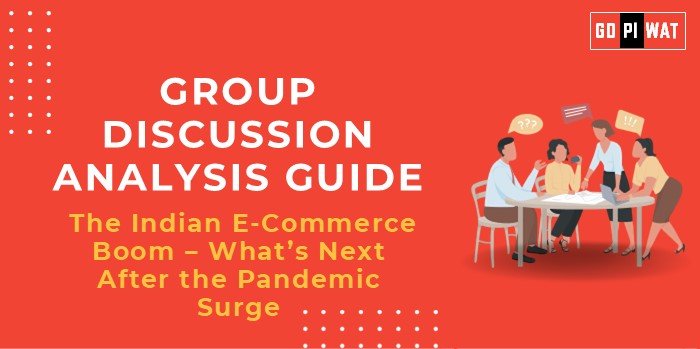📋 Group Discussion Analysis Guide: The Indian E-Commerce Boom – What’s Next After the Pandemic Surge?
🌐 Introduction to the Topic
The Indian e-commerce sector has experienced significant growth, with its market size estimated at USD 112.93 billion in 2024 and projected to reach USD 299.01 billion by 2029.
This rapid expansion is driven by increased internet penetration, smartphone adoption, and a pandemic-induced shift in consumer behavior.
📊 Quick Facts and Key Statistics
- Market Size: USD 112.93 billion in 2024, projected to reach USD 299.01 billion by 2029.
- Internet Users: 751.5 million users in January 2024 with a penetration rate of 52.4%.
- Digital Payments: UPI transactions have grown substantially, facilitating seamless e-commerce adoption.
- Rural Connectivity: 95.15% of villages now have 3G/4G mobile connectivity as of April 2024.
🔑 Stakeholders and Their Roles
- Government: Implements policies like Digital India and develops infrastructure to boost the sector.
- Private Companies: E-commerce giants such as Amazon, Flipkart, and emerging startups drive competition and innovation.
- Consumers: Increasingly opt for online shopping due to convenience and variety.
- Logistics Providers: Strengthen delivery networks to meet the growing e-commerce demand.
📈 Achievements and Challenges
🏆 Achievements
- Market Expansion: Projected CAGR of 21.5% from 2024 to 2029.
- Digital Payment Integration: Widespread use of UPI enhances transaction convenience.
- Rural Reach: Over 95% of villages connected with 3G/4G networks as of 2024.
- Startup Ecosystem: India is home to over 1,500 e-commerce startups fostering innovation in AI and logistics.
⚠️ Challenges
- Regulatory Hurdles: Complex policies around FDI and data localization create uncertainties.
- Cybersecurity Risks: Increasing incidents of data breaches and online fraud.
- Urban-Rural Divide: Rural consumers account for only 20% of online purchases, indicating scope for improvement.
🌟 Global Comparisons
- China: Dominates rural e-commerce with platforms like Taobao and Pinduoduo.
- US: Leads in AI-driven logistics and warehouse automation.
📚 Case Studies
- Flipkart’s Kirana Network: Partners with local stores for optimized last-mile delivery in Tier-3 and Tier-4 cities.
- Reliance JioMart: Revolutionized hyperlocal grocery delivery leveraging Jio’s telecom infrastructure.
💬 Structured Arguments for Discussion
Supporting Stance:
“India’s e-commerce boom signifies economic democratization, bringing global goods and services to remote areas.”
Opposing Stance:
“The sector’s growth is uneven, with urban dominance and logistical bottlenecks in rural India.”
Balanced Perspective:
“While Indian e-commerce has achieved remarkable milestones, addressing regulatory uncertainty and rural inclusion is crucial for sustained progress.”
📑 Effective Discussion Approaches
- Opening Approach: “India’s e-commerce market, poised to reach $299 billion by 2029, demonstrates its transformative potential.”
- Counter-Argument: “While cybersecurity concerns are valid, India’s Data Protection Act aims to address these risks effectively.”
📉 Strategic Analysis of Strengths and Weaknesses
Strengths:
- High smartphone penetration.
- UPI dominance.
- Robust logistics ecosystem.
Weaknesses:
- Inconsistent policies.
- Cybersecurity vulnerabilities.
- Limited rural consumer engagement.
🔗 Connecting with B-School Applications
- Real-World Applications: AI-driven consumer behavior analytics, sustainable supply chains, public-private partnerships.
- Sample Interview Questions:
- “What strategies can bridge the urban-rural gap in India’s e-commerce sector?”
- “How has UPI transformed online shopping in India?”


